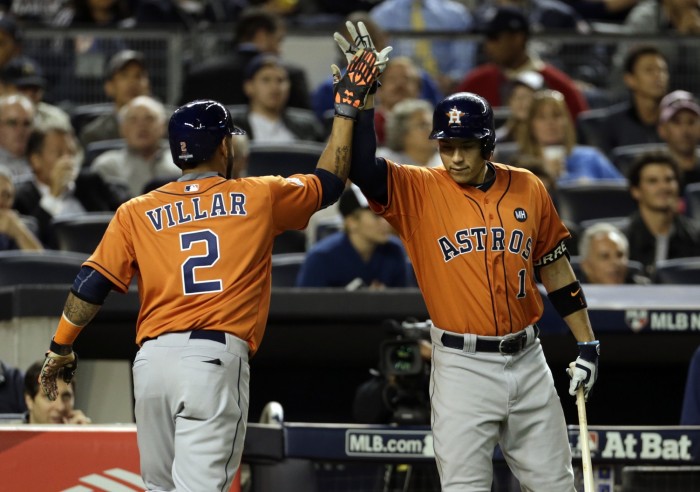The Brewers have spent a lot of the offseason importing young and/or unproven players, as a rebuilding club should. Players such as Garin Cecchini, Colin Walsh, and Josmil Pinto will receive opportunities to make a name for themselves in 2016. If they take off, they’ll remain on the team for 2017 and beyond, to help it return to contention. Of course, the fact that Milwaukee could acquire these players testifies to their skill level — each has significant flaws, and they probably won’t get better from here.
Jonathan Villar, to an extent, represents the best-case scenario for players in this mold. Signed by the Phillies as an international free agent, he went to the Astros in the 2010 Roy Oswalt trade. In the Houston farm system, he started to gain some traction, making the team’s top prospect lists for 2011 and 2012. Both times, BP praised his tools and potential, while noting his limited upside. Writing on the former list, Kevin Goldstein put it best: “He’s everything a scout would look for in a shortstop, except for hitting ability and fielding consistency.”
Villar has since become a big leaguer, and a solid one, too. Over 658 career plate appearances, he’s accrued 2.0 WARP. That’s about an average level of production — in 2015, batters averaged 2.0 WARP per 600 plate appearances — and it looks sustainable: PECOTA projects Villar to earn 1.4 WARP in 470 trips this season. For a team that won’t contend, a satisfactory player has a good deal of value.
Villar’s performance, on the surface, doesn’t seem especially average. A sickly .239 lifetime TAv, along with just -0.3 FRAA, makes Goldstein’s words look pretty prescient. Villar has succeeded, relatively, despite a terrible bat and a mediocre glove. His prosperity comes from his baserunning, which have granted him 7.0 runs above an average player and has made him an asset.
Some of that stems from stolen bases. Villar has done so 42 times at the major-league level while failing on 14 attempts, as reflected in his Stolen-Base Runs of 2.3. But that’s only about a third of his value; the rest comes from advancement, which he’s done as well as anyone. Had he compiled his 4.7 lifetime Advancement Runs in 2015 alone, he would rank 11th in baseball, between Jason Heyward and Ben Revere. Villar’s ability to move ahead and snare the extra bag has helped him get ahead, figuratively speaking.
While speed accounts for some of this — only the quickest players can steal that many bases — it can’t explain everything. Take, for example, this play from last season:
Not many players will bolt from third to home in an instant, as Villar does here. That has as much to do with smarts as it does with talent — Villar’s heads-up approach allowed him to move up. We see a similar phenomenon in this 2013 play:
Villar pauses after rounding third yet keeps his eyes on the ball, ensuring that he can take advantage of any miscues. When the error happens, he’s all the way home in the blink of an eye. We shouldn’t credit his speed for this — intelligence brought him home.
These kinds of aggressive plays have defined Villar’s game over the past three seasons. According to Baseball-Reference, he’s taken an extra base on 59.3 percent of singles and doubles (the MLB average is usually below 40 percent). He’s also advanced 14 times on fly balls, passed balls, wild pitches, balks, and defensive indifference. These can add up over the course of a 162-game season, as Villar’s aforementioned run totals prove.
This presents a good example for the Cecchinis, Walshes, and Pintos of the world to follow. Borderline major-league types can give themselves a leg up on the competition if they excel at the little things. It doesn’t necessarily mean they should run the bases assertively — they might lean in at the plate to make pitchers hit them more often, or always look to nab the lead runner on a ground ball. Whatever they do, they should capitalize in the areas that they can to make up for their shortcomings elsewhere.
Most of the crap that the 2016 Brewers will throw at the wall won’t stick. In all likelihood, those three players will wash out, just as their former teams expected them to. That doesn’t have to be the case, though: These men can stick around, if they imitate their predecessor and cohort. They’ll fall short of stardom, but we’ll gladly settle for usefulness.

2 comments on “Jonathan Villar’s Baserunning As A Model For Fringe Players”